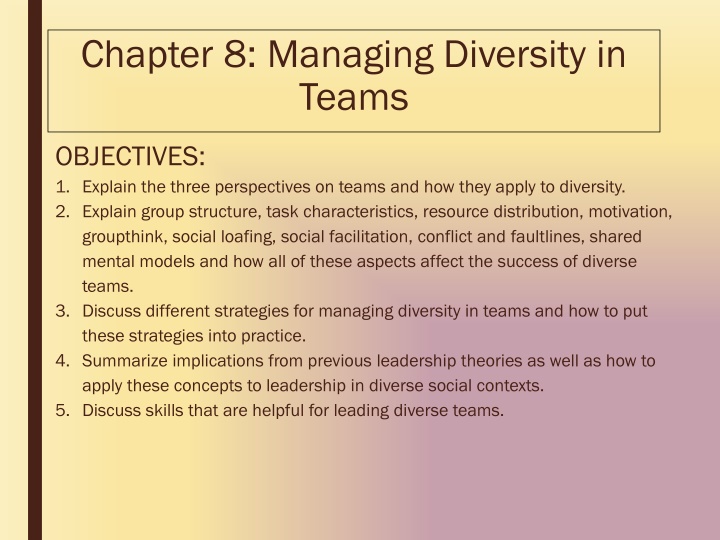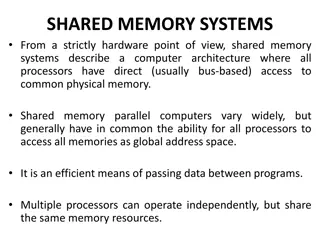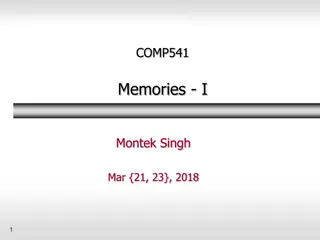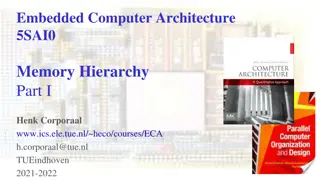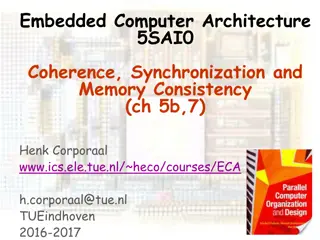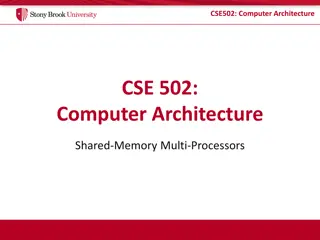Advanced Computer Architecture: Shared Memory - Processors Communication and Models
In advanced computer architecture, shared memory plays a crucial role in how processors communicate and interact with different memory models such as shared address space, centralized shared memory, and distributed memory. Each model offers unique advantages and challenges, impacting factors like ease of programming, latency, memory bandwidth, and complexity of data communication. The shared address model, data transfer mechanisms, and fundamental naming issues further influence how data is shared, addressed, and accessed by processes. Understanding these concepts is essential for designing efficient and scalable computer systems.
Download Presentation

Please find below an Image/Link to download the presentation.
The content on the website is provided AS IS for your information and personal use only. It may not be sold, licensed, or shared on other websites without obtaining consent from the author.If you encounter any issues during the download, it is possible that the publisher has removed the file from their server.
You are allowed to download the files provided on this website for personal or commercial use, subject to the condition that they are used lawfully. All files are the property of their respective owners.
The content on the website is provided AS IS for your information and personal use only. It may not be sold, licensed, or shared on other websites without obtaining consent from the author.
E N D
Presentation Transcript
Chapter 8: Managing Diversity in Teams OBJECTIVES: 1. Explain the three perspectives on teams and how they apply to diversity. 2. Explain group structure, task characteristics, resource distribution, motivation, groupthink, social loafing, social facilitation, conflict and faultlines, shared mental models and how all of these aspects affect the success of diverse teams. 3. Discuss different strategies for managing diversity in teams and how to put these strategies into practice. 4. Summarize implications from previous leadership theories as well as how to apply these concepts to leadership in diverse social contexts. 5. Discuss skills that are helpful for leading diverse teams.
Managing Diversity in Teams Group A bounded collection of people who are interdependent, share common purpose, participate in social interaction with one another, and see themselves as a group Team Common purpose of responsibility for accomplishing a particular task Pseduo-team Boundaries, common purpose and responsibility or other team characteristics are NOT present Why should diversity professionals & managers know about teams? Most work with a team, employees are expected to work with people they may not like, team settings provide opportunities for development, may need to advise others about issues involving team dynamics, advantages and disadvantages of diversity are most evident in teams
Managing Diversity in Teams Continued Ad hoc groups Groups formed for research purposes for a limited time Structure Static snapshot of relationships among group members at a particular point in time Process Dynamic ways in which relationships change over time Emphasizes task interactions or socio-emotional interactions
Systems Theory Developed during the 1930 s Organizational psychologists think of teams as open systems A semi-permeable boundary Interdependent internal parts of subsystems, so that change in one produces ripples of change in others Inputs from the environment, internal process, and output from the environment Dependency upon the external environment for sustaining resources and to use output Systems perspective suggests: Changes in one area will impact all areas Information and input as well as environmental response to output are all constantly changing the system Highlights team s relationship with environment and interdependency among members
The Group Productivity Model Useful for considering how teams can function more effectively Actual productivity depends on two things Potential productivity The best a team can do determined by task and resources Process losses Due to member motivation and coordination
The IMOI Framework Inputs ->Mediators->Outputs->Inputs Extends the systems framework to show how team performance develops over time through a series of interaction cycles Each member brings unique attributes, skills and perceptions These inputs impact team performance but are mediated by team process and psychological states Leads to outcomes such as member satisfaction and commitment and the cycle repeats
Mannix and Neale When working with diverse teams they recommend considering Organizational context, underlying processes, how diversity is understood Suggestions about managing diversity within teams 1. Consider team task and goals 2. Focus on leadership and group process to use and coordinate differences among team members 3. Strengthen influence of minority viewpoints
Group Structure and Process in Diverse Teams Role structure Roles are expectations for behaviors of people and how they will interact with others Pooled interdependence Contributions of different individuals are combined to make the product Sequential interdependence One person s output becomes input for next person (assembly line) Reciprocal interdependence Work together, going back and forth among members
Task Characteristics Team functioning is constrained by the tasks that members are responsible for. How an assignment is chosen, by whom, how clearly task is defined When a task is to choose, a well-managed process can lead diverse team members to find and correct errors, which groups excel at. In negotiating, conflict is inherent because parties preferences are likely to be different or contradictory. In execution, process is often discretionary; teams will do best when process is controlled
Resource Distribution Distribution of resources among members is important and related to internal diversity On some tasks, resource differences can help a team complete a task (one person with technical skills, one with organization, writing, public speaking, etc.) Bell et al. 2018 conclusions a) Teams are more cooperative and confident when members value teamwork b) High-ability team members work better together c) The effect of surface-level differences depends on context whether differences create faultlines and how that is managed Transactive memory Knowledge among members about task-relevant information and how it is distributed and used Information Sampling Bias When teams tend to focus on information that they hold in common and do not make use of individual skills and knowledge
Motivation and Coordination Motivation Concerns members interest in the task as well as others in the team Cohesive team When members are strongly attracted to the team and its members Only sometimes perform better Associated with good communication and performance Can also bring strong conformity norms that impair problem-solving Can become more of a problem if team members focus time and energy excessively on non task activities Dominant group members were found to be less committed when more minorities were present Effects of diversity are strongly influenced by Inclusive behavior of leaders and climate of the organization
Groupthink When a cohesive team overestimates its correctness while resisting opposing opinions, therefore developing strong conformity norms Causes teams to overlook the best outcomes or alternatives, while making faulty decisions that sometimes come with major consequences Symptoms of Groupthink identified by Janis (1982) Illusion of invulnerability, group rationalization, belief in group morality, stereotyped views of opponent, direct pressure, illusion of unanimity, self-censorship and mindguards (members who enforce agreement) Overcoming Groupthink Leader can refrain from stating a preference, all members advised to think critically about alternatives and to voice concerns, a devil s advocate can be assigned, involve outside experts, and the leader can guide a search for contradictory information Abilene Paradox When a team makes a decision despite unexpressed disagreement from team members
Social Loafing or Free Riding Social Loafing Occurs when someone does not do their share of the work How to reduce/eliminate If the task is involving, attractive or interesting, the team is very cohesive and the team s goals are high Free-riding Implies that reduced effort occurs because group members believe the group will be successful without their contributions Strategies to avoid free-riding and social loafing Teams not larger then necessary, ground rules for participation and goal accomplishment, open discussion for expectations, matching member roles to areas of strength, peer feedback, attention to lack of participation, an attractive and a cohesive team
Social Facilitation Social Facilitation Increased motivation when work is done by people working in the presence of others Occurs when behavior is easy or well-learned and others presence has positive effects
Conflict and Faultlines Relationship conflict Difference in values, preferences, personality or previous negative interactions Harmful to productivity and satisfaction Task Conflict Conflict about the nature or importance of work Both positive and negative effects Process Conflict Concerns differences about procedures, leadership, role and responsibilities Faultlines Emergence of conflicts in diverse teams along latent dividing lines that become activated by an event relevant to subgroup differences
Shared Mental Models Team Mental Model (TMM) A shared understanding about team, work and environment With a strong TMM, members agree about membership, roles, task, process, timeframe, and other key factors Based on research done on military teams A more diverse team may result in less agreement on TMM
Techniques for Eliciting Diverse Ideas Round-Robin Individuals first privately write a response to a problem, then a facilitator records one answer at a time from each participant, after discussion a private vote is collected and the facilitator determines the group decision Delphi Technique Best used in complex decision-making situations when knowledgeable experts cannot interact directly Anonymous survey so participants can separately consider the problem and make recommendation, a facilitator gathers the responses and creates another survey to evaluate. Continue until a solution is reached. Nominal Group Technique Generating ideas, sharing and recording ideas, group discussion, voting, data analysis Individually generate ideas, then round-robin discussion after everyone has shared ideas. This prevents people from dominating the conversation.
Categorization Strategies Categorization can happen when members of a diverse team or members of different teams collaborate. Ingroup/outgroup distinctions may develop leading to negative attributions and judgement. Below are strategies to reduce conflict. De-categorization Weakening group boundaries by changing the focus on interactions from group-based to person-based Re-categorization A new superordinate category is created to which all members belong Sub-categorization Emphasizes a common goal, but at the same time value differences Cross-categorization Intentionally forming teams and assigning roles across categories to reduce hierarchal relationships
Inclusive Leadership Leaders play a critical role in diverse team performance Includes coordination, obtaining and managing resources, defining and structuring tasks, and motivating members Below are a list of leadership theories that were developed without considering diversity Trait Approach Personal attributes distinguishing leaders from non-leaders Leader Behavior Approach What successful leaders actually do Contingency Theories Most effective behavior is contingent upon situation Leader-Member Exchange (LMX) Focus on quality of relationship between leader and members Cognitive Theories Emphasis on how followers think of leaders and leadership Transformational Emphasis on personal quality & behavior of leaders who motivate others
Implications from Earlier Theories Those in leadership roles differ from successful leaders and personal qualities do not predict success, they describe only those who have attained leadership roles It is useful to study successful leaders behavior Successful leaders are contingent upon aspects of a situation It is is important to consider the leader s relationship with individuals as well as the team as a whole Cognitive theories imply that leaders are identified and evaluated based on expectations and stereotypes of others Leadership involves transactions between leaders and members, but also an emotional connection that motivates others.
Leadership in Diverse Social Contexts Chrobot-Mason considered diversity leadership from perspectives of leading self, others and the organization. Leading oneself Implies continual development of understanding and claiming one s own social identity as well as identity as a leader. Leading others Becomes more challenging in a diverse team High quality LMX is likely to develop when leader/subordinate dyads are demographically similar This could have negative consequences and leaders should develop high-quality relationships with each member Leading the organization Includes understanding costs of ignoring or mismanaging diversity and communicating the importance of DEI
Skills for Diversity Leadership Working with heterogeneous individuals The leader must build respectful relationships with individuals by acknowledging unique ways each can contribute Working with the team as a whole Fostering collective goals, reducing negative attitudes, managing conflict, encouraging positive attitudes toward members of other subgroups, while respecting identity differences Suggestions for leaders to lead across differences Proactively study team and organizational situations, develop a clear message for those involved in conflict as well as larger group, develop and evaluate options for handling conflict, respond appropriately, learn from conflict situations, and finally create norms and expectations.
Hackman Model Teams must Meet or exceed client expectations Become more capable over time as members learn Provide experience of learning and personal well-being for members Characteristics of effective teams Productive output Growth as a team Learning and fulfillment of team members Conditions for effectiveness A real team, compelling direction, enabling structure, supportive context, expert coaching in teamwork
Leading Virtual Teams Virtual teams consist of members who are geographically separated or work together using electronic media Factors that affect the success of virtual teams Leadership, planning and setting expectations, managing conflict, trust and psychological safety, matching technology to message Leadership in virtual teams requires communication, collaboration and coordination Four key actions to building a virtual team Ensuring that members agree on and master technology, establishing shared understanding of how technology will be used, ensuring agreement on roles, building trust and cohesion
